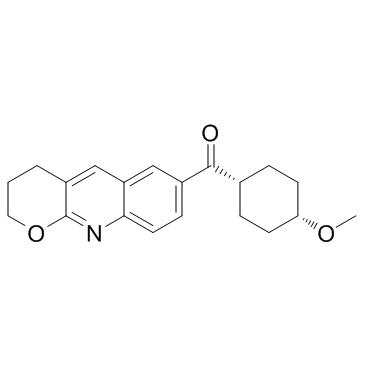| In Vivo |
JNJ16259685 (0.125, 0.25, 0.5, 1, 2, 4 and 8 mg/kg, i.p) significantly reduces the time spent in digging behaviours (0.25-8 mg/kg), threat (all doses) and attack, in comparison with vehicle group[1]. JNJ16259685 (30 mg/kg) produces very minimal effects on locomotor activity. JNJ16259685 dramatically reduces rearing behavior, exploration of a novel environment and lever pressing for a food reward (rat: 0.3 mg/kg; mouse: 1 mg/kg). Subcutaneously administered JNJ16259685 (30 mg/kg) has no effect on reflexive startle responses to loud auditory stimuli or foot shock in mice[2]. JNJ16259685 exhibits high potencies in occupying central mGlu1 receptors in the rat cerebellum and thalamus (ED50=0.040 and 0.014 mg/kg, respectively)[3].
|
| Animal Admin |
Mice[1] Nine groups of mice are used. Animals are randomLy allocated to two control groups (n=15 each) receiving only saline or saline (90%) plus DMSO (10%), and seven experimental groups (N=14-16 each) receiving JNJ16259685 injections. JNJ16259685 is diluted in saline (90%) plus DMSO (10%) to provide appropriate doses for injections and administered in seven doses: 0.125, 0.25, 0.5, 1, 2, 4 and 8 mg/kg. The doses are chosen on the basis of recent behavioural studies using this compound. Drug or vehicle is injected intraperitoneally in a volume of 10 mL/kg. Rats[2] This procedure is used to measure overt behavioral, neurological and autonomic responses to the drug challenge. Briefly, rats are randomLy separated into four groups (n=6), each of which receives a different dose (0, 3, 10, or 30 mg/kg) of JNJ16259685. An expert observer, blind to the drug treatment of the animals, assesses and scores the animals at 30, 60, 120, and 240 min post-injection. The animals are assessed for passivity, body elevation, limb position, limb tone, body tone, gait, and pupil size. For each of these behaviors, a score of 0 is assigned to animals that appeared “normal”, whereas scores of±1,±2, or±3 indicated mild, moderate, or severe increases (+) or decreases (−) from normality. Individual animals that receive a score of±2, or greater, are considered to be significantly effected on the measure. A dose is considered to have a significant effect if 3 or more of the animals receive a score of greater than±2.
|
